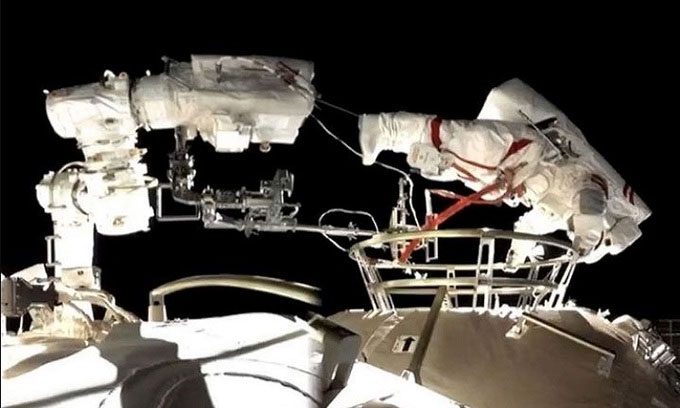For the first time, two astronauts successfully conducted a spacewalk to install equipment on the exterior of the new space station in orbit.
Liu Boming and Tang Hongbo began their Extravehicular Activity (EVA) at 7:11 AM on July 4, according to Hanoi time. Liu was the first to exit the central module named Tianhe of the space station, followed by Tang about three hours later. Wearing China’s advanced Feitian astronaut suits, the duo installed essential tools on the space station to support future operations.

Astronaut Liu Boming working outside the space station on July 4. (Photo: CCTV).
Initially, Liu worked alone, attaching foot restraints and a support frame to the end of the space station’s 10-meter robotic arm, before climbing up. Shenzhou 12 commander Nie Haisheng monitored the arm’s control equipment, maneuvering Liu from inside the Tianhe module.
Connected by a tether to a handrail running along the exterior of the space station, Tang coordinated with Liu on the task of adjusting the panoramic camera. They continued to install additional equipment together with the assistance of the robotic arm. After approximately seven hours of work outside the space station, the Shenzhou 12 crew successfully completed all assigned tasks during the spacewalk. Liu and Tang concluded their EVA at 1:57 PM on July 4, according to Hanoi time. The astronauts are set to conduct a second spacewalk in the near future. In addition to checking procedures, they will prepare for the space station to receive two additional laboratory modules, scheduled for launch in 2022.
China’s first spacewalk was conducted by Zhai Zhigang, the commander of the Shenzhou 7 mission in 2008. Liu was also a member of that mission and wore a Russian Orlan spacesuit. The Feitian suit features a similar design to the Orlan, equipped with a mobile life support system. The helmet of the Feitian suit is outfitted with a camera providing a first-person view, akin to NASA’s EMU suit.
In addition to the spacewalk, the Shenzhou 12 crew configured and tested systems within the Tianhe central module, conducted scientific experiments, and participated in video calls. Upon completion, the T-shaped Tianhe space station will be China’s first multi-module space station.




















































